2. In groups, read the sample writing and complete the table below.
(Theo nhóm, đọc bài viết mẫu và hoàn thành bảng dưới đây.)
A severe drought took place this summer in the Mekong Delta region. The rainy season arrived late last year and was shorter than usual. The rainfall was 8 percent lower than normal at 1,240 mm. The drought had severe effects on people’s lives. The rice crop died due to the shortage of water. Farmers lost their jobs and had to leave the countryside to work in the cities. Many people had to buy water for daily use at a very high price. To overcome this situation, hundreds of volunteers brought water tanks to help affected people in the drought areas.
|
What is the natural disaster? |
|
|
What happened? |
|
|
Where and when did it happen? |
|
|
What are the effects of this disaster? |
|
|
What have been done to help the victims of the disaster? |
|
Tạm dịch:
Một đợt hạn hán nghiêm trọng đã diễn ra vào mùa hè năm nay ở khu vực đồng bằng sông Cửu Long. Mùa mưa năm ngoái đến muộn và ngắn hơn mọi năm. Lượng mưa thấp hơn 8% so với bình thường ở mức 1.240 mm. Hạn hán đã ảnh hưởng nghiêm trọng đến cuộc sống của người dân. Lúa bị chết do thiếu nước. Nông dân bị mất việc làm và phải rời nông thôn để làm việc ở các thành phố. Nhiều người dân đã phải mua nước sinh hoạt với giá rất cao. Để khắc phục tình trạng này, hàng trăm tình nguyện viên đã mang thùng nước đến giúp người dân vùng hạn hán bị ảnh hưởng.
|
What is the natural disaster? (Thảm họa thiên nhiên là gì?) |
A severe drought (Một đợt hạn hán nghiêm trọng) |
|
What happened? (Chuyện gì đã xảy ra?) |
The rainy season arrived late last year and was shorter than usual. The rainfall was 8 percent lower than normal at 1,240 mm. (Mùa mưa năm ngoái đến muộn và ngắn hơn mọi năm. Lượng mưa thấp hơn 8% so với bình thường ở mức 1.240 mm.) |
|
Where and when did it happen (Nó xảy ra ở đâu và khi nào?) |
A severe drought took place this summer in the Mekong Delta region (Một đợt hạn hán nghiêm trọng đã diễn ra vào mùa hè năm nay ở khu vực đồng bằng sông Cửu Long.) |
|
What are the effects of this disaster? (Những ảnh hưởng của thảm họa này là gì?) |
The drought had severe effects on people’s lives. The rice crop died due to the shortage of water. Farmers lost their jobs and had to leave the countryside to work in the cities. Many people had to buy water for daily use at a very high price. (Hạn hán đã ảnh hưởng nghiêm trọng đến cuộc sống của người dân. Lúa bị chết do thiếu nước. Nông dân bị mất việc làm và phải rời nông thôn để làm việc ở các thành phố. Nhiều người dân đã phải mua nước sinh hoạt với giá rất cao.) |
|
What have been done to help the victims of the disaster? (Những gì đã được thực hiện để giúp đỡ các nạn nhân của thảm họa?) |
To overcome this situation, hundreds of volunteers brought water tanks to help affected people in the drought areas. (Để khắc phục tình trạng này, hàng trăm tình nguyện viên đã mang thùng nước đến giúp người dân vùng hạn hán bị ảnh hưởng.) |

Các bài tập cùng chuyên đề
Bài 1 :
Read the passage carefully and choose the correct answer.
Severe flooding occurred during the 2011 monsoon season in Thailand. The flooding began at the end of July caused by the landfall of Tropical Storm Nock-ten. These floods soon spread through the provinces of northern, northeastern, and central Thailand along the Mekong and Chao Phraya river basins. In October, floodwaters reached the mouth of the Chao Phraya and made parts of Bangkok flooded. Flooding continued in some areas until! mid-J anuary 2012, and resulted in a total of 815 deaths (with 3 missing) and 13.6 million people affected. Sixty-five of Thailand’s 77 provinces were declared flood disaster zones, and over 20,000km* of farmland was damaged. The disaster has been described as “the worst flooding in terms of the amount of water and people affected.”
(https://en.wikipedia.org/wiki/2011Thailand-floods)
Bài 2 :
Read the following passage and choose the best answer for each blank.
El Nino is a weather phenomenon of the Pacific Ocean which is (1) _____ by an abnormal (2)___ of water on the surface of the ocean. It has the (3) ____ to influence global weather patterns as it brings drought to some continents and (4)_____ rain to others. It was first (5) ___ by fishermen coming from Spanish ports in the Pacific in the 17th century. It got its name (Spanish for “boy child”) because it usually takes (6)___ near Christmas time. It can cause catastrophic (7)____. The 1982 El Nino (8)____ in 1,500 deaths, but it can be a lot worse than that. Sea animals, (9)___ fish and birds, also die in large numbers. It is (10)______ that sailors in the Pacific can smell the dead sea-life during El Nino.
Bài 3 :
Read the following passage about tornadoes and choose the best answer.
TORNADOES
Did you ever see the movie The Wizard of Oz? A tornado sweeps up Dorothy and Toto, sending them to a new world where there are witches and talking lions! That entire story is fiction, but tornadoes are real and they are serious business. In fact, they can be the most dangerous storms of all.
Tornadoes are sometimes referred to as twisters or cyclones. They are shaped like a cylinder. They are born in thunderclouds. The winds inside a tornado swirl around and around and can be more than 300 miles per hour (mph). The winds are so strong that tornadoes can lift animals, cars, and even houses.
The United States has more tornadoes than any other country in the world. States such as Texas, Oklahoma, Kansas, and Nebraska are hit hard by tornadoes. This part of the country is known as “Tornado Alley.” Tornado season is during the springtime and summer. If the conditions are right, a tornado can happen any time of year.
Bài 4 :
Read the passage and choose the correct answer to complete the passage.
A drought is a period or condition of unusually dry weather within a geographic area where rainfall is normally present. During a drought there is a (1) ______ of precipitation. Droughts occur in all climatic zones. However, its characteristics vary significantly (2) ______ one region to another.
Its (3) ________ depends on the degree of the water shortage, size of area affected, and the duration and warmth of the dry period. In many underdeveloped countries, such as India, people place a great demand on water supply. During a drought period (4) ________ is a lack of water, and thus many of the poor die.
(5) ________ drought cannot be reliably predicted, certain precautions can be taken in drought-risk areas. These include construction of reservoirs to hold emergency water supplies, education to avoid over cropping and overgrazing, and programs to limit settlement in drought-prone areas.
Bài 5 :
Choose the best answer to fill in each numbered blank in the text below.
When violent events happen outside the control of humans, they are called natural disasters. Natural forces are the causes of these events. There are many kinds of natural disasters, and they can (1) ________loss of life, injury, and damage to property.
So, can we predict natural disasters? The answer is a definite 'yes' for (2) ________kinds of natural disasters. Scientists understand the factors that lead to storms, tornadoes, and floods. (3) ________, it is much more difficult to predict earthquakes and volcanic eruptions. Some volcanos (4) ________leak gases or pour out lava before erupting, but others do not give any warnings at all. It is also difficult to predict earthquakes although scientists are (5) ________of the regions where earthquakes are most likely to happen.
Bài 6 :
Exercise 8. Listen to an interview about a natural disaster and decide if the statements are Right or Wrong.
Bài 7 :
Read the text and choose the correct answer to fill in each blank.
Landslides are the mass movement of rocks or earth (1) _________ a slope. Landslides occur more frequently in some mountainous areas. They may come suddenly (2) _________ a storm or heavy rain. When you hear a warning about a landslide in your area, you (3) _________ do the following:
- Follow the instructions about emergency information given by authorities.
- Go to a public shelter if you feel it is (4) _________ to remain in your home.
- Listen to unusual sounds, such as trees cracking, or rocks knocking together.
- Stay away from the slide area. There may be a danger of additional slides.
- (5) _________ for flooding, which may occur after a landslide.
- Stay cautious after the storm. Don’t do the clean-up until the storm is over.
Bài 8 :
Choose the correct answer A, B, C, or D to fill in each blank in the following passage.
Tornadoes
A tornado is a kind of storm which looks like a huge funnel. Tornados are the strongest winds on earth. They can (1) _________ 480 km per hour. With such great strength, a tornado causes a lot of damage. It can root up trees, flatten buildings, and throw heavy things such as cars hundreds of meters. It is especially dangerous (2) _________ people in cars or mobile homes.
Tornadoes differ in their duration and the distance they travel. Most (3) _________ less than ten minutes and travel five to ten kilometers. Some special tornadoes can last several hours and travel up to more than 150 km!
Tornadoes can occur almost (4) _________ on earth, but most of them happen in the United States, especially in the Great Plains region. This area may (5) _________ more than 200 tornadoes in each year.
Bài 9 :
Choose the item among A, B, C or D that best answers the question about passage.
Two of the most dangerous storms which affect America are hurricanes and tornadoes. They are very much feared by anyone who may live in the path of their destruction.
Every year homes are destroyed by their fury and often lives are lost. Most people who live near the coast are forced to evacuate their homes and to move to safer areas until the storm passes. Floods are caused along the coasts by both the heavy rain and a storm tide that is considerably above normal water level. The high winds, coastal flooding and heavy rains associated with a hurricane cause enormous damage.
Hurricanes usually develop between July and October. Once they hit land they carry tremendous power with driving rain and wind.
Tornadoes are violent low - pressured storms. These storms occur most often during the summer months and are noticeable by their strong wind and lack of rain. The sky turns black as dust is sucked up into the air. Tornadoes are capable of lifting quite heavy objects from the ground. They can pick up trees and cars right into the air and even uplift heavier objects such as homes and railway cars.
Both hurricanes and tornadoes cause millions of dollars worth of damage to life and property every year. Today they can be predicted more easily than in the past, but they cannot be stopped or ignored.
Bài 10 :
1. Listen and read.
(Nghe và đọc.)
Tom: You look pretty sad, Mi. What's the matter?
Mi: My uncle called us this morning. Our hometown has been affected by a flood. It’s the second time this year.
Tom: I'm sorry to hear that. How are things there now?
Mi: My uncle, his wife, and his children are all safe. They moved everything to the second floor of their house last night. Are there natural disasters in your hometown in the US?
Tom: Yes, we sometimes have tornadoes.
Mi: Tornadoes? Sounds strange. What's a tornado?
Tom: It’s a violent storm that moves in a circle with very strong winds. I still remember the tornado we had last year.
Mi: What happened?
Tom: One evening my parents and I were having dinner. Suddenly, we heard a very loud noise. When we looked out of the window, we saw a big funnel of wind moving towards us.
Mi: Did it cause any damage?
Tom: Yes, a lot. It damaged the roof of our house and pulled up some trees in our yard. Fortunately, no one was hurt.
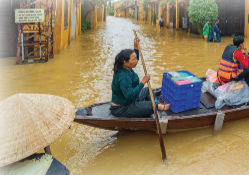
Bài 11 :
2. Read the conversation again. Complete each sentence with no more than TWO words from it.
(Đọc đoạn hội thoại một lần nữa. Hoàn thành mỗi câu với không quá HAI từ từ đoạn hội thoại.)
1. There is a _____ in Mi's home town.
2. Her uncle’s family had to move everything to the _____ last night.
3. A tornado is an example of a _____.
4. Tom’s family _____ dinner when the tornado came.
5. The tornado damaged their roof and _____ up some trees in their yard.
Tom: You look pretty sad, Mi. What's the matter?
Mi: My uncle called us this morning. Our hometown has been affected by a flood. It’s the second time this year.
Tom: I'm sorry to hear that. How are things there now?
Mi: My uncle, his wife, and his children are all safe. They moved everything to the second floor of their house last night. Are there natural disasters in your hometown in the US?
Tom: Yes, we sometimes have tornadoes.
Mi: Tornadoes? Sounds strange. What's a tornado?
Tom: It’s a violent storm that moves in a circle with very strong winds. I still remember the tornado we had last year.
Mi: What happened?
Tom: One evening my parents and I were having dinner. Suddenly, we heard a very loud noise. When we looked out of the window, we saw a big funnel of wind moving towards us.
Mi: Did it cause any damage?
Tom: Yes, a lot. It damaged the roof of our house and pulled up some trees in our yard. Fortunately, no one was hurt.
Bài 12 :
3. Read the short passages below. Decide which natural disaster each person below is talking about.
(Đọc các đoạn văn ngắn dưới đây. Quyết định xem mỗi người dưới đây đang nói về thảm họa thiên nhiên nào.)
Nam: We were travelling on the road near a mountain. Suddenly, a lot of rocks and mud came down the mountain.
(Chúng tôi đang ở trên đường gần một ngọn núi. Bất ngờ, rất nhiều tảng đá và bùn rơi từ trên núi xuống.)
Ann: While I was working in the garden, I saw a big funnel of wind moving towards us very quickly.
(Khi tôi đang làm việc trong vườn, tôi thấy một cái phễu gió lớn đang tiến đến gần tôi rất nhanh.)
Tom: Suddenly, everything in our living room began to shake. My sister and I quickly hid under the table.
(Bất ngờ, mọi thứ ở trong phòng khách bắt đầu rung lắc. Chị tôi và tôi nhanh chóng lẩn trốn dưới bàn.)
Bài 13 :
2. Read the two news articles. Matched the highlighted words with their meanings.
(Đọc hai bài báo. Nối các từ được đánh dấu với ý nghĩa của chúng.)
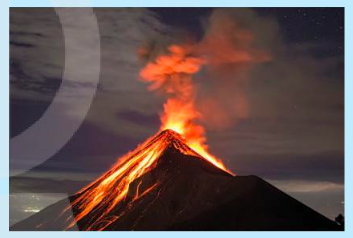
A volcano in the South Pacific erupted violently last Saturday. It hit Tonga, an island country in the area. The eruption sent a cloud of ash and gas into the air. People could see this cloud from 20 kilometres away. The eruption also caused a tsunami which flooded properties in Tonga’s capital. Besides, it destroyed hundreds of homes on some small islands. More than twenty people on these islands are still missing. New Zealand sent two big ships to Tonga to help the victims yesterday.

Residents in tall buildings in Ha Noi were frightened when they felt a slight shaking for about 30 seconds last night. “I was watching TV when my building started trembling. Books, lights, and other things also moved”. Ms Nguyen Ha, a resident in the Sunshine Building, shared. Many people living in the building ran out of their homes in fear. According to scientists, a strong earthquake in China caused this shaking. Luckily, there was no damage.
|
1. violently |
a. not yet found |
|
2. tsunami |
b. slightly shaking |
|
3. missing |
c. the bad feeling you have when you are frightened |
|
4. trembling |
d. very strongly |
|
5. fear |
e. very large waves in the sea |
Bài 14 :
3. Read the articles again and answer the questions.
(Đọc lại bài viết và trả lời câu hỏi)
1. Where and when did the eruption happen?
(Khi nào và ở đâu vụ phun trào xảy ra?)
2. What did the eruption cause?
(Vụ phun trào gây ra cái gì?)
3. What were the other effects of the eruption?
(Những ảnh hưởng khác của vụ phun trào là gì?)
4. How long did the buildings shake?
(Các tòa nhà lắc trong bao lâu?)
5. What caused the shaking?
(Điều gì gây ra sự rung lắc?)
Bài 15 :
Reading
1. Read the passage and tick (✓) T (True) or F (False) for each sentence.
(Đọc đoạn văn và đánh dấu (✓) T (True) hoặc F (Sai) cho mỗi câu.)
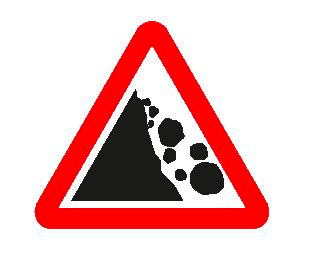
Landslides are the mass movement of rocks or earth down a slope. Landslides occur more frequently in some mountainous areas. They may come suddenly after a storm or heavy rain. When you hear a warning about a landslide in your area, you should do the following:
- Follow the instructions about emergency information given by authorities.
- Go to a public shelter if you feel it is unsafe to remain in your home.
- Listen to unusual sounds, such as trees cracking, or rocks knocking together.
- Stay away from the slide area. There may be a danger of additional slides.
- Watch for flooding, which may occur after a landslide.
- Stay cautious after the storm. Don’t do the clean-up until the storm is over.
|
|
T |
F |
|
1. Landslides hardly ever occur in mountainous areas. |
|
|
|
2. You should follow the instructions about landslide emergencies. |
|
|
|
3. Avoid going to public shelters as they are unsafe. |
|
|
|
4. Landslides may occur one after another. |
|
|
|
5. You should stay cautious until the storm is over. |
Bài 16 :
a. Read the quick facts on a website about a famous disaster. Which of the following topics is NOT mentioned?
(Đọc thông tin nhanh trên một trang web về một thảm họa nổi tiếng. Chủ đề nào sau đây KHÔNG được đề cập?)
A. Where it happened (Nơi nó xảy ra)
B. The damage it caused (Thiệt hại nó gây ra)
C. How people stayed safe (Làm thế nào mọi người giữ an toàn)
What was the biggest typhoon?
The biggest typhoon was Typhoon Tip.
Where was Typhoon Tip?
Typhoon Tip happened over the Pacific Ocean. It affected parts of many countries including Japan, the Philippines, North and South Korea, and China.
When was Typhoon Tip?
Typhoon Tip lasted from October 4 to October 24, 1979.
How much damage did Typhoon Tip cause?
Typhoon Tip caused lots of rain and floods on islands in the Pacific Ocean. In Japan, floods damaged twenty-two thousand homes and twenty-seven bridges. The storm left eleven thousand people without a home. It also caused millions of dollars of damage to farms.
How many people died in Typhoon Tip?
Ninety-nine people died from Typhoon Tip. The storm caused a fire in Japan. The fire killed 13 people and hurt 68 others. It also caused lots of floods in Japan. The floods killed 42 people, and 44 other people died on boats at sea.
Bài 17 :
b. Now, read and write True, False, or Doesn't say.
(Bây giờ, hãy đọc và viết True, False hoặc Doesn’t say.)
According to the website, (Theo trang web,)
1. Typhoon Tip was the biggest tsunami ever.
2. the typhoon affected Japan, South, Korea, and Vietnam.
3. Typhoon Tip lasted longer than any other storm.
4. the storm damaged more than twenty thousand homes.
Bài 18 :
c. Listen and read.
(Nghe và đọc.)
Bài 19 :
a. Read the emergency announcement and choose the best heading.
(Đọc thông báo khẩn cấp và chọn tiêu đề tốt nhất.)
1. Flood warning from the National Weather Service
(Cảnh báo lũ lụt từ Dịch vụ thời tiết quốc gia)
2. Hello everyone from the city of Flagstaff. This is an emergency announcement to tell you some information about the floods and heavy rain.
(Xin chào mọi người đến từ thành phố Flagstaff. Đây là một thông báo khẩn cấp để cho bạn biết một số thông tin về lũ lụt và mưa lớn.)
|
Sent: 20:15 July 11 (Gửi: 20 giờ 15 phút ngày 11 tháng 7) What: Flooding (Cái gì: Lũ lụt) Where: Flagstaff City (Ở đâu: Thành phố Flagstaff) When: From 22:30 July to 08:00 July 12 (Thời gian: Từ 22:30 tháng 7 đến 08:00 ngày 12 tháng 7) Heavy rains in the mountains are causing the water to rise in the Blue River. Water could be as high as one meter in the center of Flagstaff City. We expect damage to buildings, houses, and cars. (Mưa lớn ở vùng núi khiến nước sông Blue dâng cao. Nước có thể cao tới một mét ở trung tâm Thành phố Flagstaff. Chúng tôi cho rằng sẽ có thiệt hại cho các tòa nhà, nhà cửa và ô tô.)
|
Instructions (Hướng dẫn) Have an escape plan. (Có một kế hoạch trốn thoát.) Have emergency items ready to go. (Chuẩn bị sẵn các vật dụng khẩn cấp.) Stay in the highest part of your home. (Ở trong phần cao nhất của ngôi nhà của bạn.) Move food and important things to the highest part of your home. (Di chuyển thức ăn và những thứ quan trọng đến phần cao nhất của ngôi nhà của bạn.) Do not walk or drive into the flood water. (Đừng đi bộ hoặc lái xe vào vùng nước lũ.) Board up your lower windows. (Lên các cửa sổ thấp hơn của bạn.) Watch local TV or listen to the radio for more information and instructions. (Xem truyền hình địa phương hoặc nghe đài để biết thêm thông tin và hướng dẫn.) Be prepared to leave your home and follow your escape plan. (Hãy chuẩn bị rời khỏi nhà của bạn và làm theo kế hoạch thoát hiểm của bạn.) |
Bài 20 :
b. Now, read and write short answers.
(Bây giờ, đọc và viết câu trả lời ngắn.)
1. Where is the warning for?
(Cảnh báo dành cho đâu?)
Flagstaff City.
(Thành phố Flagstaff)
2. When will the warning end?
(Khi nào cảnh báo kết thúc?)
.
3. What should people have ready to go?
(Mọi người nên chuẩn bị gì?)
.
4. Where should people stay?
(Mọi người nên ở đâu?)
.
5. Where can people leg more information?
(Mọi người có thể biết thêm thông tin ở đâu?)
.
Bài 21 :
c. Listen and read.
(Nghe và đọc.)
Bài 22 :
Look and read. Choose the correct answer (A, B or C).
(Nhìn và đọc. Chọn câu trả lời đúng (A, B hoặc C).)
WILDFIRE WARNING FROM THE NATIONAL WEATHER SERVICE
(CẢNH BÁO CHÁY CHÁY TỪ CƠ QUAN THỜI TIẾT QUỐC GIA)
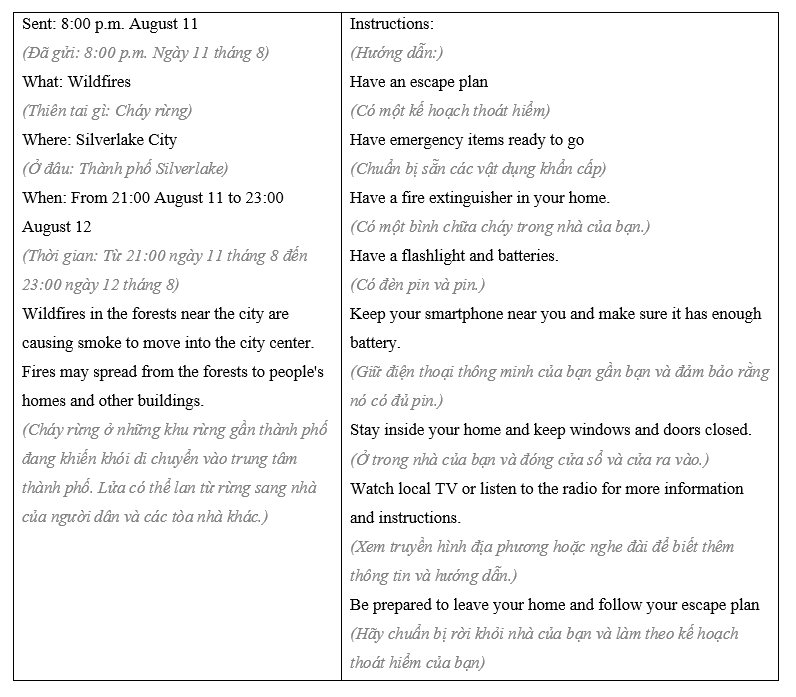
Example:
(Ví dụ:)
0. The announcement is about .
A. a flood
(lũ lụt)
B. wildfires
(cháy rừng)
C. an earthquake
(một trận động đất)
Answer: B
1. The wildfire warning .
(Cảnh báo cháy rừng .)
A. is for the city of Riverview
(dành cho thành phố Riverview)
B. ends the next day
(kết thúc vào ngày hôm sau)
C. ends the same day 1 at p.m.
(kết thúc cùng ngày lúc 1 chiều)
2. People should have .
(Mọi người nên có .)
A. lots of food
(nhiều thức ăn)
B. lots of fresh water
(nhiều nước ngọt)
C. batteries
(tắt điện)
3. People should .
(Mọi người nên .)
A. stay in their homes
(hàng xóm của họ)
B. turn off the electricity
(kế hoạch trốn thoát của họ)
C. go to the store to buy what they need
(đi đến cửa hàng để mua những gì họ cần)
4. People should follow .
(Mọi người nên làm theo .)
A. their neighbors
(hàng xóm của họ)
B. their escape plans
(kế hoạch trốn thoát của họ)
C. the smoke
(khói)
Bài 23 :
5. Look at the pictures. What natural disasters are they? Listen and read to find out.
(Nhìn vào những bức tranh. Đó là những thiên tai nào? Nghe và đọc để tìm hiểu.)
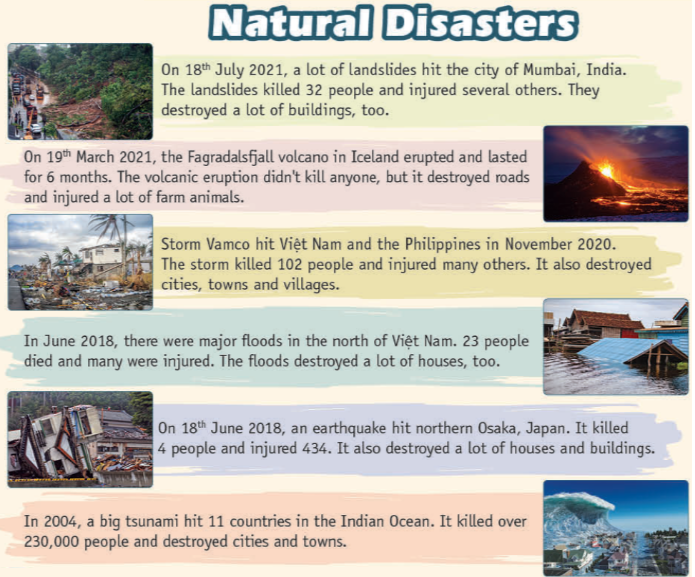
Bài 24 :
6. Read the text and complete the table.
(Đọc văn bản và hoàn thành bảng.)
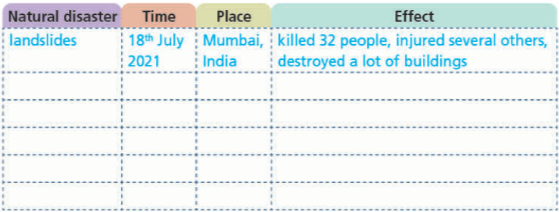
Bài 25 :
Reading
1. Look at the pictures and put them in the order of the story.
(Nhìn vào những bức tranh và đặt chúng theo thứ tự của câu chuyện.)

WHAT A DISASTER!
It was a beautiful morning in June and the sun was shining. My parents and I were having a wonderful holiday in Hawaii. We swam in the sea and walked on the beach every day. On our last day, we decided to go hiking up a volcano. We were climbing near the top of the volcano when we heard a loud noise coming from deep under the ground. Then, the volcano shook, smoke came out of the top, and lava came down the side. We were terrified! We ran as fast as we could back down the volcano. We felt worried because so much lava erupted from the top. Luckily, we got to the road and a bus picked us up just in time. We drove off quickly. Later, we watched the news to find out what happened. The eruption didn't injure anyone, bit destroyed some buildings and cars. We felt relieved because everyone was safe.
Bài 26 :
2. Read the text and answer the questions (1-5).
(Đọc văn bản và trả lời câu hỏi (1-5).)
1. Where did the disaster happen?
(Thảm họa xảy ra ở đâu?)
2. What was the writer doing when it started?
(Tác giả đang làm gì khi nó bắt đầu?)
3. What came down the side of the volcano?
(Cái gì đã chảy xuống bên sườn núi lửa?)
4. Did the disaster injure anyone?
(Thảm họa có làm ai bị thương không?)
5. How did the writer feel after the disaster?
(Tác giả cảm thấy thế nào sau thảm họa?)
Bài 27 :
1. Look at the pictures and read the title of the text. What do you think text is about?
(Nhìn vào những bức ảnh và đọc tiêu đề của văn bản. Em nghĩ bài viết viết về điều gì?)
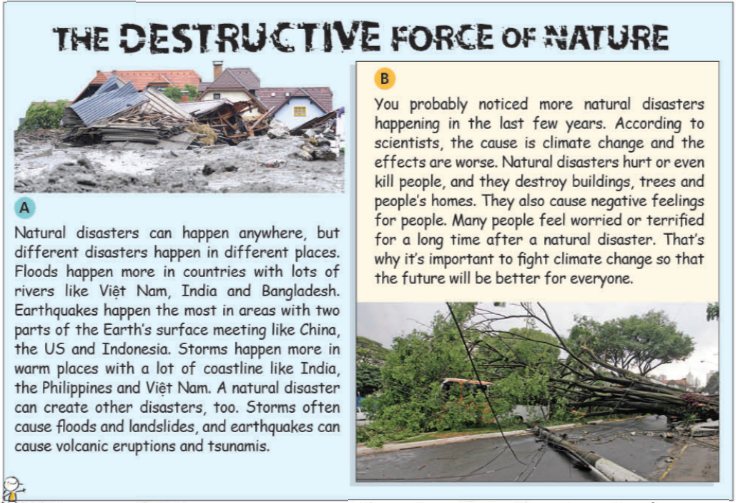
Bài 28 :
2. Read the text and answer the questions (1-5). Write A or B.
(Đọc văn bản và trả lời câu hỏi (1-5). Viết A hoặc B.)
Which paragraph…
(Đoạn nào…)
1. describes how people feel after a natural disaster?
2. talks about a natural disaster causing other disasters?
3. explains the cause of natural disasters?
4. describes what happens to people and places after a natural disaster?
5. explains why natural disasters happen more in one place than other places?
THE DESTRUCTIVE FORCE OF NATURE
A. Natural disaster can happen anywhere, but different disasters happen in different places. Floods happen more in countries with lots of river like Việt Nam, India and Bangladesh. Earthquakes happen the most in areas with two parts of the Earth's surface meeting like China, the US and Indonesia. Storms happen more in warm places with a lot of coastlines like India, the Philippines and Viet Nam. A natural disaster can create other disasters, too. Storms often cause floods and landslides, and earthquakes can cause volcanic eruptions and tsunamis.
B. You probably noticed more natural disasters happening in the last few years. According to scientists, the cause is climate change and the effects are worse. Natural disasters hurt or even kill people, and they destroy buildings, trees and people’s homes. They also cause negative feelings for people. Many people feel worried or terrified for a long time after natural disaster. That's why it’s important to fight climate change so that the future will be better for everyone.
Bài 29 :
Reading
7. Read the text and decide if the statements (1-5) are R (right), W (wrong) or DS (doesn't say).
(Đọc đoạn văn và quyết định xem các câu (1-5) là R (đúng), W (sai) hay DS (không nói tới).)
Kate’ Blog
Hello, readers! Today's blog is about my family's holiday on an island in the Pacific Ocean. I went hiking with my parents in the mountains every day. On our last day, when we were climbing through the forest, the earth stared to shake. The sound of rocks falling was very loud. We thought it was an earthquake or a landslide. We were terrified! Then, we heard a loud noise, but we didn’t know where it came from. When we looked down at the valley, a tsunami was hitting the village below. We quickly climbed up the mountain path when the water was moving through the valley. Final, we were safe enough and we stopped to look down at the valley. There was water everywhere! We went back down to help in any way we could. It was terrible! Some people died and many got injured. We went home the following day. We were relieved because our family was, safe from a terrible natural disaster.
1. On her holiday, Kate went hiking every day.
2. When the disaster started, Kate and her parents knew it was a tsunami.
3. They climbed down the mountain when they saw the tsunami.
4. The tsunami killed a lot of people.
5. Kate's family went home in a car.
Bài 30 :
2. Listen and read the text. Find one unusual fact about the storm in the text.
(Nghe và đọc văn bản. Tìm một sự thật bất thường về cơn bão trong văn bản.)
Venezuela's Special Storms
You might find storms fascinating or frightening. But can they be positive? If you live in Venezuela, your answer may be: yes! In 1995, a storm in Venezuela saved the country. How did that happen? Foreign sailors wanted to attack, but they saw strange lightning. It looked pinkish-orange, so they didn’t know what it was. They felt scared. In the bright light of the storm, soldiers on land spotted the ships.

















